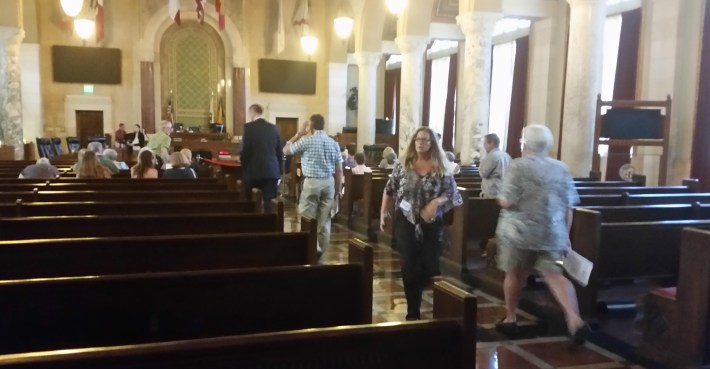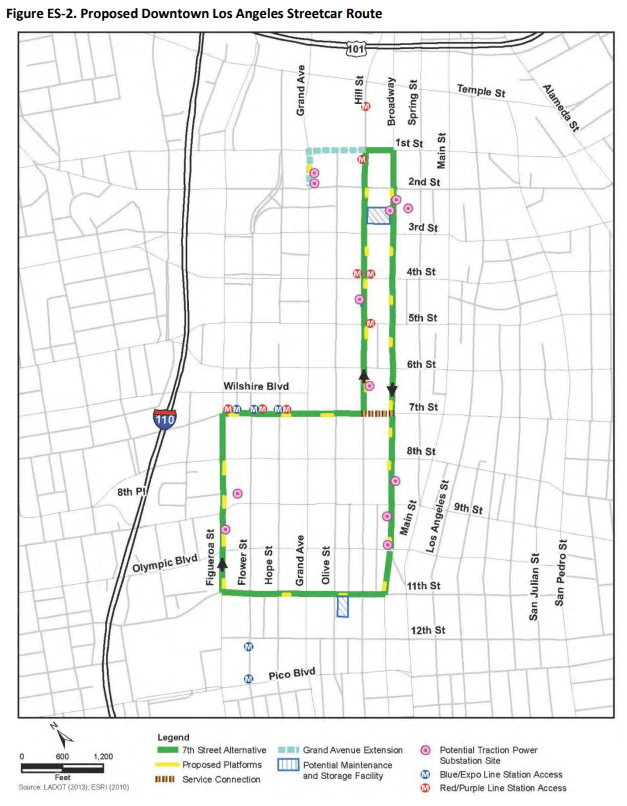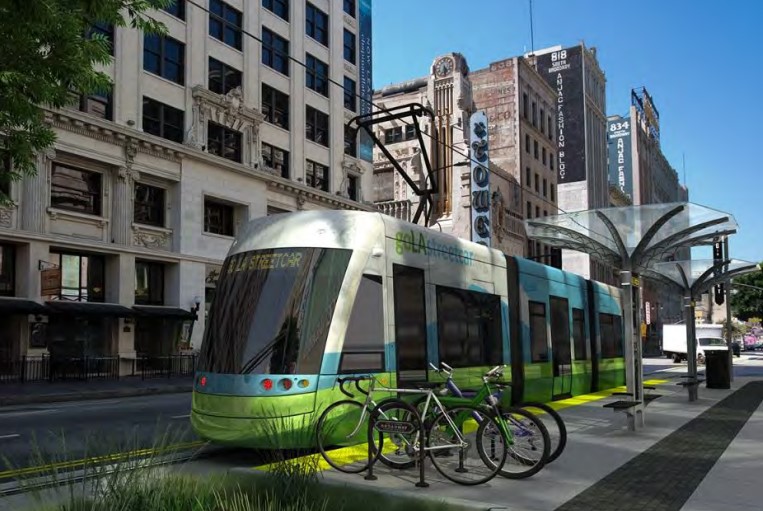Last week the city of Los Angeles approved a funding plan for the planned Downtown Los Angeles Streetcar project. Though the project has a lot of support downtown, it will need some heavy lifting to accelerate Metro funds that would not otherwise kick in until decades from now.
Out of curiosity at what kind of turnout it would draw I attended the August 2nd public hearing on the draft Environmental Assessment (EA) for the Downtown L.A. Streetcar Project. The title of the post I wrote about the hearing, “If Last Week’s Hearing Was Any Indication, Enthusiasm Is Low for Downtown Streetcar,” sums up what I observed. Quite frankly I thought after the hearing that the only thing to occur in the near term regarding the project would be the August 21 closure of public comment on the EA. Submit comments today.
But to my surprise, KNBC posted on its website that the project's Funding Plan was on the agenda of a Los Angeles City Council Planning and Land Use Management (PLUM) Committee meeting on August 14. I felt honor bound to attend and see if it offered any signs of active support versus what I saw at the first meeting, which was essentially none.

When I arrived early at the hallway outside the council chambers where the committee was to meet, I found a healthy number of people waiting. However, I quickly discovered almost all of them were there not for the streetcar but instead to oppose several developments also on the agenda.
It has been a while since I attended a committee meeting. They have entered the 21st century, and you now sign up to make public comment via an electronic kiosk. The start time was supposed to be 2:30 p.m. but Chair José Huizar did not call the meeting to order until 2:47 p.m. I was gratified to note that all five council members on the Committee had shown up: alongside Huizar, that includes Curren Price, Marqueece Harris-Dawson, Mitch Englander, and Bob Blumenfield. (Meeting audio is posted on the city website - the streetcar discussion is between 10:00 and 28:30).
A few other items were heard before they took up the streetcar Funding Plan.
Actually a comment on the project was heard in advance of the item. Alfredo Madrid of the Downtown Weekly came to the podium and confessed to still familiarizing himself with the project. He referenced the historic Red Cars, asked if this is intended over time to bring back something like that. Later we spoke and he peppered me with questions but, after showing a desire to contact me later with any other questions he never did so, and since his article was posted on August 15. I guess he decided he didn’t have any more questions.
First there was a brief report on the project by Ida Rubio, Senior Administrative Analyst with the Office of the City Administrative Officer (CAO.)
The streetcar actions agendized before the committee were threefold:
- Approve the funding plan for the Downtown L.A. Streetcar project for construction costs under a Construction Manager/General Contractor or alternative project delivery method.
- Authorize the Los Angeles Department of Transportation (LADOT) to submit a federal Small Starts grant application by the September 7 deadline.
- Instruct the LADOT to submit a proposal to the Los Angeles County Metropolitan Transportation Authority (Metro) Board within sixty days for accelerated funding of up to $200 million under Measure M.
Sixty seconds was alloted to each speaker. First up was Shane Phillips, Director of Public Policy for the Central City Association (CCA) and former Project Director for Los Angeles Streetcar, Inc. (LASI). The CCA supports the project, he said, and encourages the city to go forward with it. Downtown growth will be hobbled if gridlock prevails, he pointed out, and the streetcar is needed as part of a comprehensive livable communities approach (along with bike-share, more welcoming sidewalks, affordable housing, and less parking). It would also provide downtown access to the regional transit network, address first/last mile challenges, and fill a service gap.
The second speaker was me. I briefly noted my affiliations with the Rail Users’ Network, Southern California Transit Advocates and Streetsblog L.A. Then I mentioned the poor turnout at the recent hearing, which motivated my attendance. With no particular feelings for or against the project, I do have concerns about its high costs and the projected lackluster ridership. I observed that the chief reason given for streetcars in other areas is to motivate development and, given that downtown is already enjoying a building boom, I had to wonder whether the streetcar is still justifiable on that basis.
The third speaker was Steve Needleman, a property owner on Broadway and chair of LASI. The property owners along Broadway support the project, he said, and have proven it via the funds being generated by the Community Facilities District taxes that they approved in 2012. The project is shovel-ready, he said, and he urged it go forward and for the city to make the effort to secure additional funding.
The fourth speaker was Shiraz Tangri, General Counsel of LASI. In his remarks he noted downtown has undergone growth, which will continue, that this is the first new transit system during this growth period dedicated to improving circulation through downtown, and that it is urgently needed to get cars off the road.
The fifth speaker was Nick Griffin, Senior Vice President of Economic Development at the Downtown Center Business Improvement District. He also spoke of the downtown boom, emphasizing that the streetcar would enhance it as well as offer opportunities for economic development and marketing, particularly in the Broadway core.
The sixth speaker was Hilary Norton, Executive Director of Fixing Angelenos Stuck in Traffic and FASTLinkDTLA. She spoke of the role of the streetcar in addressing anticipated growth, saying that it would reduce traffic, improve mobility, and be an accessible option for those using wheelchairs, strollers, and those needing easier assistance boarding vehicles. Norton also stated that streetcars in Seattle and Portland were not just a catalyst for development, but they got people away from single-occupancy vehicles, facilitated tourism, and aided families with young children who want to move around differently and travel together. It was time for the project to move forward, she concluded.
The seventh and final speaker was Wallis Locke, Director of Communications & Policy at the South Park Business Improvement District. Locke noted that widespread support for the project has been shown at meetings and by the passage of the Community Facilities District tax. Furthermore, she stated, it will enhance mobility and is shovel-ready, which will allow quick construction. Locke stressed that the fiscal impact is minimal, with no city general fund money going to the project. She also stated that it supports downtown investment, is in line with street enhancements like MyFigueroa, and provides more options as downtown grows.
Chair Huizar thanked the CAO for its report and expressed appreciation for the supportive speakers. He described the long process the project has undergone, stressing that it is widely supported both in downtown and other parts of the region. Huizar called the streetcar a “great transportation system” to address anticipated growth in the downtown residential population, plus a burgeoning influx of tourists and visitors and the proliferation of destinations that will draw crowds. Huizar stated that the streetcar is a needed first/last mile option, especially to connect with the Regional Connector, and that, like in Portland and Seattle, it will be an economic development driver.
In response to my comments that downtown already has plenty of development, he claimed the Broadway corridor (between 1st and 11th Streets) still needs stimulus and incentives. He further stated such developments as the ACE Hotel and the soon-to-open Apple store anticipated the streetcar – without it those developments wouldn’t have happened, he said. And a final reason he offered was to draw on the legacy of the historic red cars.
He summarized the project's status: environmental clearance is winding down; it is at the thirty percent design stage; current funding sources include the tax district and Measure M. The streetcar has $200 million from Measure M's voter-approved expenditure plan, though that funding is currently not scheduled until 2053. Huizar expressed hope that the environmental plans would aid his effort to accelerate the Measure M funds, and suggested the possibilities of a private/public partnership and/or federal funding. Regarding the paltry attendance at the EA hearing I mentioned, Huizar asserted that hundreds if not thousands of supporters have shown up for other meetings and he hopes this is the start of the final steps toward reaching the end of a long process.
The Committee approved all three actions “without objection.” The next day, it was heard at the full City Council, which passed it without discussion under the consent calendar. Mayor Garcetti approved it on Wednesday, per the official action summary.

The 3.8-mile project is now estimated to cost $291 million, plus another $15.6 million for a possible Grand Avenue extension. Proponents have put forward an optimistic timeline where, if construction starts in 2019, it could be finished in 2021.
Lately the streetcar project has drawn criticism from Curbed LA, LAist, and the Los Angeles Times editorial board.
L.A. Downtown News coverage remains supportive.
We will see how it fares in its quest for accelerated Measure M funds and federal funding. Frankly I am not holding my breath.







